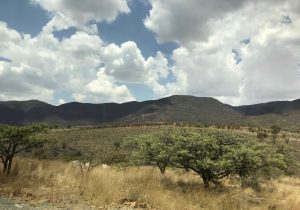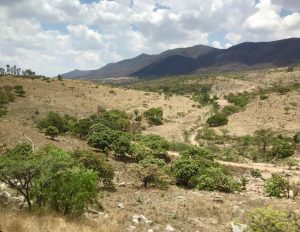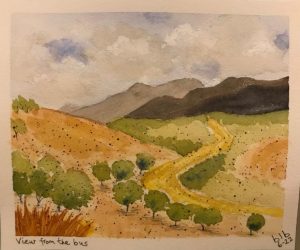Ask any Returned Peace Corps Volunteer (RPCV) what the biggest, longest-lasting personal benefit of their two-year service overseas has been, and my guess is most will answer in one word: adaptability. Spin RPCVs around, toss them in the air high enough to drop them into another country, and they’ll likely, like cats, land on their feet and adapt to that new culture in record time. Why? Because we’ve learned how.
We learned how, I believe, early in our PC service, to let go of American expectations of what’s “normal.” That word quickly flies out the door of our cement-block houses or mud-and-wattle huts in towns and villages seldom shown on printed maps. “Normal” becomes a nonword, meaningless as a measure.
My favorite example of this comes from my experience in the middle of the rainforest of Gabon, Central Africa, where – after having given up a ten-year career as a caterer in New York City to join the Peace Corps at age fifty-one – I found my little house on the hill had no refrigerator. And I was unable to buy one.
As I wrote in my memoir, How to Cook a Crocodile (Peace Corps Writers, 2010), “If you live in equatorial Africa and you can’t afford a refrigerator, you might as well kiss butter goodbye. And fresh milk and cheese and ice cream and cold drinks and yesterday’s leftovers, too, just to name a few. This was the first lesson I learned at my new post: How to live, as one might put it in the lingua franca of francophone Africa, sans frigo (without a fridge).”
The trick, I discovered, petit a petit (little by little), was to shop for fresh foods daily and cook only as much as I needed that day — the culinary equivalent of carpe diem: Cook for Today. For me this meant walking every morning, after giving my health lecture at the hospital, the mile down hill from my house to the open-air marché in town to see what the women vendors there had to offer, then walking home in the hundred-degree heat to prepare my healthy soup du jour.
“I began to see,” I wrote at the time, “more and more clearly that not having a fridge was far from the hardship I’d at first imagined. In fact, it was a blessing, which, like so many of life’s blessings, had arrived disguised.”
Along similar lines, in my life here in San Miguel de Allende, Mexico, I count the fact that I don’t have a car a blessing in disguise. For the vast majority of Norteamericanos, having a car in their garage is as necessary, as “normal,” as having a fridge in their kitchen. For me now, though, living as a retiree on a strict budget, being sin carro (without a car) is immensely better, and I’m grateful for it.
Need I list the health and economic benefits? I walk at least two miles every day in this beautiful old colonial city, under its clear, cobalt-blue sky, breathing its mountain air. If I need to ride somewhere in town, I can hail an ever-present green taxi to take me where I need to go for just a few dollars, or I can hop on a city bus for pennies. I’m spared the stress and expense of car ownership. I’ve been there and done that in my long life in the States. Never again.
Best of all, as I’ve been reminded recently, the intercity bus system in Mexico is superb. As Richard Ferguson writes in “All About the Buses in Mexico,” “The Mexican bus system is far superior to the U.S. bus system. Since fewer people in Mexico have cars, the buses are much more heavily used. This means that many buses are available to most destinations, from third class to luxury.” (To read the whole informative article, go to:
https://www.mexconnect.com/articles/965-all-about-buses-in-mexico/ .)
Lately I’ve been traveling by Primera Plus buslines to and from the capital city of this state, Guanajuato, for appointments and loving these luxurious yet super-affordable trips. With my half-price-for-seniors INAPAM card, a one-way ticket to, or from, Guanajuato costs me only 93 pesos (about $5 USD) for the one-and-a-half-hour ride. Far less than the price of gas, I’m sure.
The buses are clean, comfortable, and well-appointed, with Wi-Fi, video screens, leg rests, overhead bins, and a toilet in the back. It’s like traveling by air; but these big, modern buses are solidly hugging the earth. All of the passengers are masked, most doze or surf their phones. Everyone is quiet – even the babies. The bus’s motor hums.
While others nod off, I sit at my window seat and take in the view from this high vantage point – Mexico’s astonishing body, her undulating mountains and piercing valleys; large patches of freshly tilled fields — the color of coffee-with-a-dash-of-cream — thirsty for the rainy season to begin; dramatic, puffed-up clouds elbowing out the sky’s blue, building, building…. In a week or two these brown fields will be baby-leaf green, and the scene will be altogether new.
I know if I were driving a car, focusing on the winding road ahead and the other cars whizzing past me, I would never really see these breathtaking scenes as they rush by.
Of course I’ve tried to capture this passing countryside with my camera, but only one or two of my photos have been worth preserving. And only one of them worth painting:




Bonnie I think your painting is really good!
So enjoyed this latest post, makes one think there has to be less waste by shopping daily.
Thank you, dear Judy. Yes, less waste — and everything is fresher! 🙂
Great article! You reminded me of my year in London, England in the 60s. No fridge! Nobody had a fridge. I did my shopping daily on the way home from work. At least when it got cold in the winter, I could put my milk outside on the window sill. I have also given up on a car here and love not having one.
Thank you, Pat dear. I was hoping other WOW readers could relate to the “joys” of living without such things. 🙂
¡¡BRAVA, querida Bonnie!! One of the top reasons I decided to stay on, post-Fulbright, was being able to live in a country which not only believes in access to art but also access to excellent public transport. Apart from CDMX (Mexico City) SMA was one of the places to which I regularly travelled on the bus from my home city of Guanajuato. I remember those first rides over there and how enchanted I was by the landscape, whatever the time of year. I still am! Thank you so much for writing about our wonderful buses in México.
Yes, Ana querida, “enchanted” is the word. I never tire of the view from the bus’s window. I’m just hoping other WOW readers here decide to take the intercity buses more often. Viva Mexico’s public transport!
I so enjoy your posts and love the pictures and your painting. I’ve been to San Miguel 5 times and am planning a visit in October. I have even traveled to Mexico City using the bus system and found it to be comfortable and efficient. I love experiencing the culture and slower pace of life that living in Mexico gives us from such fast paced places like California. Thank you for your post!
Thank you, dear Helen, for your comment and for sharing your bus-travel experiences in MX. I’m so happy you enjoy my WOWs! Best wishes, Bonnie
Lovely post and perspective. Thank you for sharing your gift of writing and your insight. Also your watercolor is beautiful!
Thank you so much, dear Susan. How kind of you!
Hey Bonnie, I love the photos and especially the painting!
Thanks, queried Kim! We must make a day trip by bus to GTO one of these days (when you get back from CA).
Bonnie, your watercolor is beautiful. i have been enjoying your Blog all through the Pandemic. My apt in the states is sin dishwasher, microwave & A/C. SM has taught me how easy it is to do without. I wish I could give up my car but there is little mass transit. Glad you are doing well. Regards, Susan Fisher
Dear Susan — So good to hear from you. I think of you every day that I use the pretty blue-and-white bowls you bequeathed to me when you left SMA, so I truly think of you often! I hope you’re doing well. Thanks so much for being such a faithful WOW reader. Best, BB
Very well-written and interesting. Loved the pictures. We share similar views about “the simple life.”
Thanks, Helaine. Yes, by now we’ve certainly learned that less is definitely more! 🙂
Bonnie, thanks so much for these excellent and enjoyable pieces. I especially appreciated the one on Mexican nicknames, as I have tried in vain for many years to find out what they are all about.
So happy to know you enjoy my WOWs, Meredith. The piece on Mexican nicknames was not mine, however; I think it was an article by Pat Hall published in SMAFAQ. Pat deserves the credit for that one. 🙂
BonnieDear, that’s a great piece of writing based on your observations about “normal” as a meaningless measure. To the learned skill of adaptability, add resourcefulness and acceptance. You also made me long for public transport! And I loved your little watercolor. Better than the photo! xoxo
Thank you, BeDear, for all this sparkling praise. I’m drinking it in like a glass of bubbly! 🙂 Yes, my guess is that the U.S. would have better public transport systems if the American auto industry didn’t have such a stranglehold on the economy. But that’s another story…
Bonnie. Like what you wrote about RPCV adaptability. Much harder at 55 than right out of college. I can’t believe you produce such great blogs every week.
Thanks, dear Stan. Well, I was 51 when I joined the PC; maybe that makes a difference!? 🙂
I’m sure you’re right, Bonnie. The auto industry and the oil industry both — nd the Republicans complete the stranglehold. They are the party of cannibalism — euphemistically called capitalism.
Hmmmm… Good one, Be: capitalism = cannibalism!
Your observations make me feel guilty having a car…. I think I’m too impatient to take buses everywhere I cannot walk! But I certainly admire you! Love reading your columns! Thank you!
Thank YOU, dear Beth. And thank you for giving me rides to our plein air events! I’m glad you have a car. 🙂
Dear Bon,
Your smart and timely post reminds me of what learned when I first moved to NY: Thinking about making do with less causes far more anxiety than actually doing it. I see it here now. People whining and complaining of the inconvenience caused by the supply chain issues resulting from Covid.
Adaptability may have been a strong American virtue in the past, but those days are gone. If anything, after two years of Covid, many Americans seem less adaptable than ever. This is concerning because the future may hold even greater challenges than those we see now.
Keep speaking your truth, Bonnie!
Love,
Paul
Thanks for this, Paul dear. I always value your perspective. Yes, from my experience of living for years in the U.S. and now from my long-distance view from here in Mexico, I’d say that at this point, especially after all the strains that COVID brought, Americans are stressed beyond their limits. And nobody is at their best when they’re so stressed. I wish I had the Answer — other than: Get out of there.
Bonnie querida, I just finished rereading How to Cook a Crocodile and How to Make an African Quilt. You are indeed an example of adaptability. You transport your readers to Africa (and here, in your blog, to San Miguel de Allende) Sin carro, indeed!
Beautiful photos!
Gracias, dearest Te, for your kind words here — and thank you for keeping my Africa memoirs alive. I deeply appreciate it. That’s exactly what I wanted to do in writing those two books: take readers to places they’ve never been and would likely never visit in person. Adelante! — xx
Your comments about Africa do bring me back. I was about the same age as you when I began going to Ghana during my summer breaks from teaching to work and learn in the field of ceramics. My normal quickly disappeared the moment my hands touched the ubiquitous red clay, and as you indicated, adaptability became the only way both survive and thrive. I cannot say I ever got used to not having a fridge, as the thing I missed the most was an ice cold drink. NOTHING was even remotely cool, not the rain or the earth or even the sea on a cloudy day. If I found myself in Accra and had the time, I would sneak off into one of the large hotels to sit in some blessed air conditioning and order a large iced tea and savor it as long as possible. It was my dirty little secret. Thanks for the memories!
Oh, this is WONDERFUL, Barbara! I’m so grateful that you took the time to share your Africa memories here. Yes, I remember how life-saving a really COLD beer (at a restaurant that had a fridge!) was at that time. And I’ve never really liked beer! 🙂